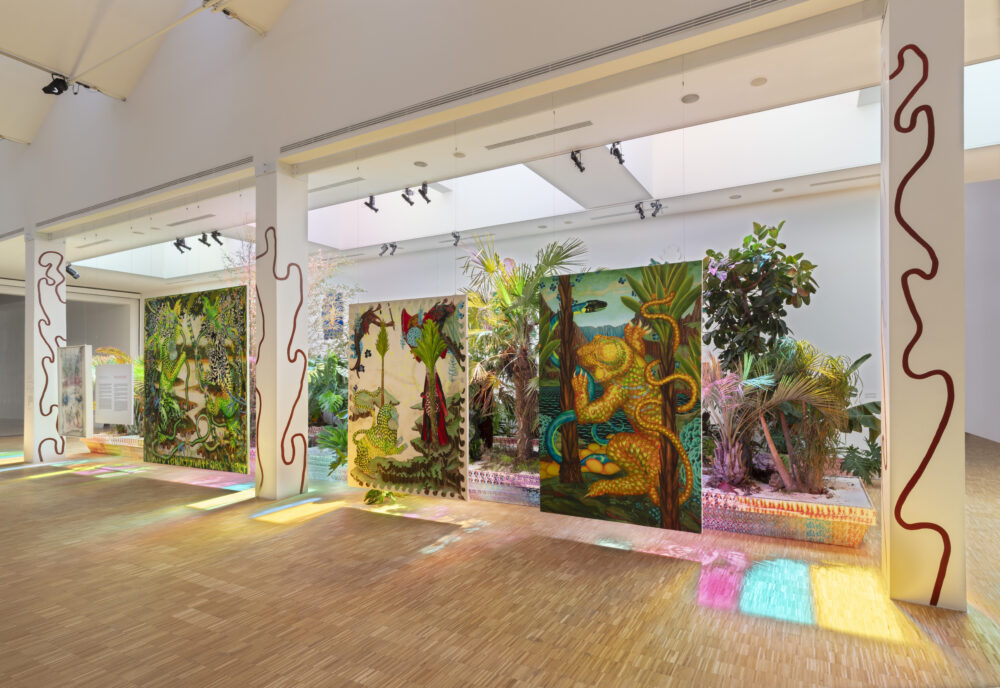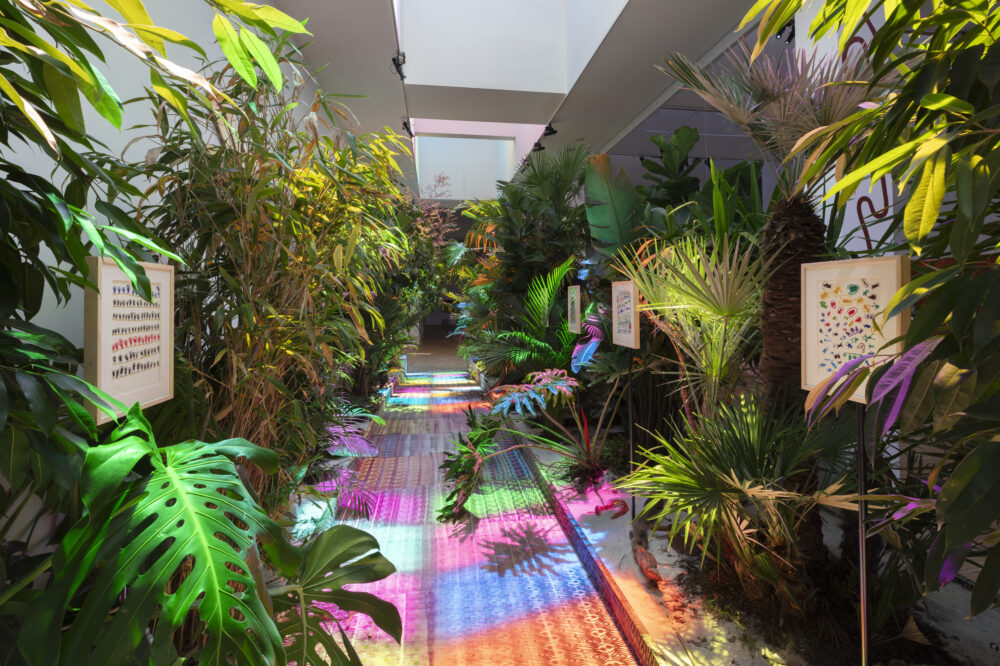
Milan
Siamo Foresta
From to
Gli artisti della mostra / Artists of the exhibition
Fernando Allen, Efacio Álvarez, Cleiber Bane, Cai Guo-Qiang, Johanna Calle, Fredi Casco, Alex Cerveny, Jaider Esbell, Floriberta Fermín, Sheroanawe Hakihiiwe, Aida Harika, Fabrice Hyber, Morzaniel Ɨramari, Angélica Klassen, Esteban Klassen, Joseca Mokahesi, Bruno Novelli, Virgil Ortiz, Santídio Pereira, Solange Pessoa, Brus Rubio Churay, André Taniki, Edmar Tokorino, Adriana Varejão, Ehuana Yaira, Roseane Yariana, Luiz Zerbini
The forest is alive. It can only die if the white people persist in destroying it: if they succeed, the rivers will disappear underground, the soil will crumble, the trees will shrivel up, and the stones will crack in the heat. The dried-up earth will become empty and silent.Davi Kopenawa, La Chute du Ciel, 2010
Image gallery

© Gianluca Di Ioia
.
© Gianluca Di Ioia
.
© Gianluca Di Ioia
.
© Gianluca Di Ioia
.Siamo Foresta mette in scena un dialogo senza precedenti tra pensatori e difensori della foresta; tra artisti indigeni – dal Nuovo Messico al Chaco paraguaiano passando per l'Amazzonia (Brasile, Perù e Venezuela) – e artisti non indigeni (Brasile, Cina, Colombia, Francia).
Nasce dal lavoro congiunto dell'artista yanomami Sheroanawe Hakihiiwe, originario dell'Amazzonia venezuelana, e di Fabrice Hyber, un artista francese che da vent'anni sta piantando una vasta foresta temperata nella Francia occidentale, allo scopo di rigenerare terre sterili.
Questo dialogo inaugurale – di foresta in foresta – si dispiega nella mostra in una prolifica conversazione estetica e metafisica tra artisti non-indigeni, ispirati dalla comune passione per i mondi viventi, e artisti indigeni impegnati nella difesa del proprio territorio.
La filosofia e l'arte contemporanea delle società indigene delle Americhe trasmettono un messaggio fondamentale: l'urgenza di ripensare il nostro ruolo tra gli esseri viventi in modo più umile. È in nome di questa consapevolezza dell’eguaglianza tra esseri viventi, e del riconoscimento della porosità dei confini che li distinguono in apparenza, che gli artisti qui presentati sono riuniti.
Siamo Foresta trae la sua ispirazione fondante da questa visione estetica e politica della foresta come multiverso egualitario di popoli viventi, umani e non umani, e come tale offre una vibrante allegoria di un mondo possibile al di là del nostro antropocentrismo. Come dicono i portavoce indigeni brasiliani: “Dobbiamo riforestare le menti per curare la Terra”.
— Bruce Albert
Siamo Foresta stages an unprecedented encounter between thinkers and defenders of the forest; between Indigenous artists – from New Mexico to the Paraguayan Chaco through the Amazon (Brazil, Peru and Venezuela) – and non-Indigenous artists (Brazil, China, Colombia, France).
It originates from a collaboration of Yanomami artist Sheroanawe Hakihiiwe, from the Venezuelan Amazon and Fabrice Hyber, a French artist who, for twenty years, has sown a vast temperate forest in the west of France to regenerate barren lands.
This inaugural dialogue – from forest to forest – unfolds in the exhibition into a prolific aesthetic and metaphysical conversation between non-Indigenous artists, inspired by their passion for the living worlds, and a large group of Indigenous artists committed to the defense of their native lands.
The philosophy and contemporary art of the Indigenous societies of the Americas convey a fundamental message: the urgency to reimagine a humbler role for humans among other living beings. All the artists who are exhibited here were brought together because of this concern for equality among all living beings and the recognition of the porosity of the borders which seemingly distinguish them.
Siamo Foresta draws its founding inspiration from this aesthetic and political vision of the forest as an egalitarian multiverse of living beings, human and non-human and, as such, offers the vibrant allegory of a possible world beyond our anthropocentrism. As the Indigenous leaders of Brazil say: "We need to reforest minds to cure the Earth".
— Bruce Albert
La Fondation Cartier pour l'art contemporain presenta la grande mostra Siamo Foresta, con ventisette artisti di cui sei cineasti, in un originale allestimento dell'artista brasiliano Luiz Zerbini. Questa mostra è erede di vari progetti della Fondation Cartier dedicati ai mondi viventi, tra i più recenti Le Grand Orchestre des Animaux nel 2016, seguito nel 2019 dalle mostre Nous les Arbres, Trees nel 2021 e Les Vivants nel 2022.
The Fondation Cartier pour l'art contemporain presents the major exhibition Siamo Foresta, with twenty-seven artists including six filmmakers, in an original exhibition design by Brazilian artist Luiz Zerbini. This exhibition is inherited from the various Fondation Cartier projects dedicated to the living worlds - among them and most recently Le Grand Orchestre des Animaux in 2016, followed in 2019 by the exhibitions Nous les Arbres, Trees in 2021
We began by cutting man off from nature, and by constituting him a sovereign reign; it was believed that this erased its most indisputable character, namely that it is first of all a living being. And by remaining blind to this common property, we have given free rein to all abuses.Claude Lévi-Strauss
Structural Anthropology Two, 1973
Image gallery

© Gianluca Di Ioia
.
© Gianluca Di Ioia
.Public Program
Nell’ambito del Public program della mostra Siamo Foresta, curato dal filosofo Emanuele Coccia, Fondation Cartier pour l'art contemporain invita artisti, curatori e intellettuali a discutere del futuro dell’arte indigena, il modo di collezionarla e rappresentarla nei musei d’arte contemporanea e nelle fondazioni a livello globale.
As part of the Siamo Foresta exhibition, the Fondation Cartier is inviting artists, curators and thinkers to discuss the future of indigenous art, its collection and its representation in museums and contemporary art foundations around the world.
Curated by the philosopher Emanuele Coccia, two events will be held at Triennale Milano (Milan) and the Museo delle Civiltà (Rome). The two round tables invite indigenous artists and curators to come together to discuss this crucial contemporary issue.
Newsletter and social media.
To stay up-to-date with our news, follow us on